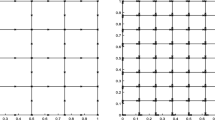Abstract
In this paper we analyze a virtual element method for the two dimensional elasticity problem allowing small edges. With this approach, the classic assumptions on the geometrical features of the polygonal meshes can be relaxed. In particular, we consider only star-shaped polygons for the meshes. Suitable error estimates are presented, where a rigorous analysis on the influence of the Lamé constants in each estimate is presented. We report numerical tests to assess the performance of the method.















Similar content being viewed by others
References
Ahmad, B., Alsaedi, A., Brezzi, F., Marini, L., Russo, A.: Equivalent projectors for virtual element methods. Comput. Math. Appl. 66, 376–391 (2013)
Antonietti, P., Beirão da Veiga, L., Manzini, G.: The Virtual Element Method and Its Applications, vol. 31. SEMA SIMAI Springer Series, Springer Cham, pp. xxiv+605 (2022)
Artioli, E., Beirão da Veiga, L., Lovadina, C., Sacco, E.: Arbitrary order 2D virtual elements for polygonal meshes: part I, elastic problem. Comput. Mech. 60, 355–377 (2017)
Artioli, E., de Miranda, S., Lovadina, C., Patruno, L.: A dual hybrid virtual element method for plane elasticity problems. ESAIM Math. Model. Numer. Anal. 54, 1725–1750 (2020)
Barrios, T.P., Gatica, G.N., González, M., Heuer, N.: A residual based a posteriori error estimator for an augmented mixed finite element method in linear elasticity. M2AN Math. Model. Numer. Anal. 40(2006), 843–869 (2007)
Beirão da Veiga, L., Brezzi, F., Cangiani, A., Manzini, G., Marini, L.D., Russo, A.: Basic principles of virtual element methods. Math. Models Methods Appl. Sci. 23, 199–214 (2013)
Beirão da Veiga, L., Brezzi, F., Marini, L.D., Russo, A.: The hitchhiker’s guide to the virtual element method. Math. Models Methods Appl. Sci. 24, 1541–1573 (2014)
Beirão da Veiga, L., Lovadina, C., Russo, A.: Stability analysis for the virtual element method. Math. Models Methods Appl. Sci. 27, 2557–2594 (2017)
Brenner, S.C., Scott, L.R.: The Mathematical Theory of Finite Element Methods. Texts in Applied Mathematics, vol. 15, 3rd edn. Springer, New York (2008)
Brenner, S.C., Sung, L.-Y.: Virtual element methods on meshes with small edges or faces. Math. Models Methods Appl. Sci. 28, 1291–1336 (2018)
Cáceres, E., Gatica, G.N., Sequeira, F.A.: A mixed virtual element method for a pseudostress-based formulation of linear elasticity. Appl. Numer. Math. 135, 423–442 (2019)
Cao, S., Chen, L.: Anisotropic error estimates of the linear virtual element method on polygonal meshes. SIAM J. Numer. Anal. 56, 2913–2939 (2018)
Chen, H., Jia, S., Xie, H.: Postprocessing and higher order convergence for the mixed finite element approximations of the eigenvalue problem. Appl. Numer. Math. 61, 615–629 (2011)
Droniou, J., Yemm, L.: Robust hybrid high-order method on polytopal meshes with small faces. Comput. Methods Appl. Math. 22, 47–71 (2022)
Gatica, G.N., Gatica, L.F., Sequeira, F.A.: A priori and a posteriori error analyses of a pseudostress-based mixed formulation for linear elasticity. Comput. Math. Appl. 71, 585–614 (2016)
Grisvard, P.: Problèmes aux limites dans les polygones. Mode d’emploi, EDF Bull. Direction Études Rech. Sér. C Math. Inform., pp. 3, 21–59 (1986)
Lepe, F., Mora, D., Rivera, G., Velásquez, I.: A virtual element method for the Steklov eigenvalue problem allowing small edges. J. Sci. Comput. 88, 44–21 (2021)
Liu, Y., Wang, J.: A locking-free \(P_0\) finite element method for linear elasticity equations on polytopal partitions. IMA J. Numer. Anal. 42, 3464–3498 (2022)
Márquez, A., Meddahi, S., Tran, T.: Analyses of mixed continuous and discontinuous Galerkin methods for the time harmonic elasticity problem with reduced symmetry. SIAM J. Sci. Comput. 37, A1909–A1933 (2015)
Mora, D., Rivera, G.: A priori and a posteriori error estimates for a virtual element spectral analysis for the elasticity equations. IMA J. Numer. Anal. 40, 322–357 (2020)
Mora, D., Rivera, G., Rodríguez, R.: A virtual element method for the Steklov eigenvalue problem. Math. Models Methods Appl. Sci. 25, 1421–1445 (2015)
Nguyen-Thanh, V.M., Zhuang, X., Nguyen-Xuan, H., Rabczuk, T., Wriggers, P.: A virtual element method for 2D linear elastic fracture analysis. Comput. Methods Appl. Mech. Eng. 340, 366–395 (2018)
Tang, X., Liu, Z., Zhang, B., Feng, M.: A low-order locking-free virtual element for linear elasticity problems. Comput. Math. Appl. 80, 1260–1274 (2020)
Tushar, J., Kumar, A., Kumar, S.: Virtual element methods for general linear elliptic interface problems on polygonal meshes with small edges. Comput. Math. Appl. 122, 61–75 (2022)
Wang, C., Zhang, S.: A weak Galerkin method for elasticity interface problems. J. Comput. Appl. Math. 419, 114726–14 (2023)
Zhang, B., Feng, M.: Virtual element method for two-dimensional linear elasticity problem in mixed weakly symmetric formulation. Appl. Math. Comput. 328, 1–25 (2018)
Zhang, B., Zhao, J., Yang, Y., Chen, S.: The nonconforming virtual element method for elasticity problems. J. Comput. Phys. 378, 394–410 (2019)
Acknowledgements
D. Amigo and F. Lepe were partially supported by DIUBB through project 2120173 GI/C Universidad del Bío-Bío and ANID-Chile through FONDECYT project 11200529 (Chile). G. Rivera was partially supported by Universidad de Los Lagos through regular project R02/21.
Author information
Authors and Affiliations
Corresponding author
Additional information
Publisher's Note
Springer Nature remains neutral with regard to jurisdictional claims in published maps and institutional affiliations.
Rights and permissions
Springer Nature or its licensor (e.g. a society or other partner) holds exclusive rights to this article under a publishing agreement with the author(s) or other rightsholder(s); author self-archiving of the accepted manuscript version of this article is solely governed by the terms of such publishing agreement and applicable law.
About this article
Cite this article
Amigo, D., Lepe, F. & Rivera, G. A virtual element method for the elasticity problem allowing small edges. Calcolo 60, 28 (2023). https://doi.org/10.1007/s10092-023-00522-8
Received:
Revised:
Accepted:
Published:
DOI: https://doi.org/10.1007/s10092-023-00522-8




